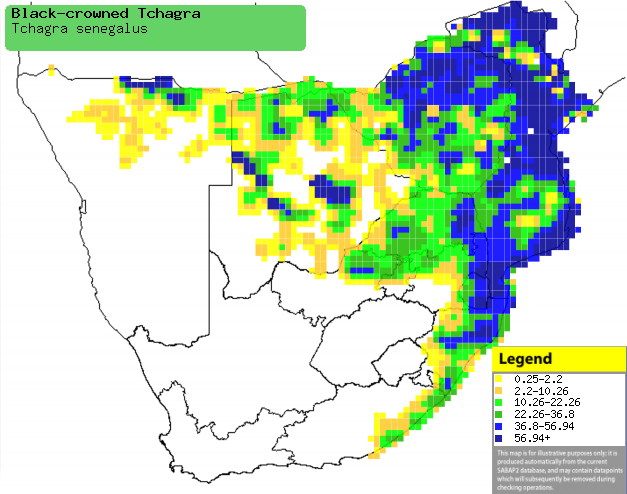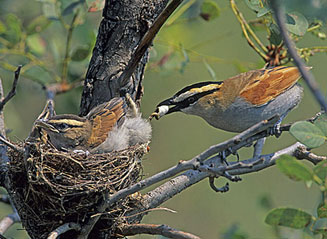|
Tchagra senegalus (Black-crowned
tchagra)
Swartkroontjagra [Afrikaans]; Umnguphane (generic term for
tchagra) [Xhosa]; umNguphane [Zulu]; Eyimba (generic term for tchagra)
[Kwangali]; Chisamaura, Nyamaburo [Shona]; Umnguphane (generic term for tchagra)
[Swazi]; Mghubhana lowu kulu [Tsonga]; Zwartkruintsjagra [Dutch]; Tchagra à
tête noire [French]; Senegaltschagra [German];
Picanço-assobiador-de-coroa-preta [Portuguese]
Life
> Eukaryotes >
Opisthokonta
> Metazoa (animals) >
Bilateria >
Deuterostomia > Chordata >
Craniata > Vertebrata (vertebrates) > Gnathostomata (jawed
vertebrates) > Teleostomi (teleost fish) > Osteichthyes (bony fish) > Class:
Sarcopterygii (lobe-finned
fish) > Stegocephalia (terrestrial
vertebrates) > Tetrapoda
(four-legged vertebrates) > Reptiliomorpha > Amniota >
Reptilia (reptiles) >
Romeriida > Diapsida > Archosauromorpha > Archosauria >
Dinosauria
(dinosaurs) > Saurischia > Theropoda (bipedal predatory dinosaurs) >
Coelurosauria > Maniraptora > Aves
(birds) >
Order: Passeriformes
> Family: Malaconotidae
Distribution and habitat
Occurs across sub-Saharan Africa, absent only from the
deserts in and around Somalia, large areas of Namibia, and much of South Africa
(excluding KwaZulu-Natal, Limpopo Province, Mpumalanga and parts of the Eastern
Cape). It is locally common throughout its range occupying dry, thorny savanna
woodland, miombo (Brachystegia)woodland and suburban gardens.
|
 |
|
Distribution of Black-crowned tchagra in southern Africa,
based on statistical smoothing of the records from first SA Bird Atlas
Project (©
Animal Demography unit, University of
Cape Town; smoothing by Birgit Erni and Francesca Little). Colours range
from dark blue (most common) through to yellow (least common).
See here for the latest distribution
from the SABAP2. |
Food
It mainly eats invertebrates, often foraging on the ground,
plucking prey from the leaf litter or grass. It also takes insects from leaves
and branches, and occasionally from dung. The following
food items have been recorded in its diet:
- Insects
-
spiders
- Amphibians (especially tadpoles)
- Reptiles
Breeding
- It is a monogamous solitary nester, with males contesting their
territories by holding singing duels; the winner is decided by how well it
can extend its neck and how loud it can call.
- The nest is a shallow cup built of rootlets, fine twigs and tendrils
bound together with spider web and typically placed in a horizontal or
vertical fork in a tree or bush. Both sexes help with the construction,
which usually takes about 7 days.
 |
|
|
Black-crowned tchagras at their nest, Sericea
farm, South Africa. [photo Warwick Tarboton ©] |
|
- It lays 1-4, usually 2-3 eggs, which are incubated mainly by the female,
for about 12-17 days.
- The chicks stay in the nest for about 13-16 days, remaining with their
parents for most of the non-breeding season.
Threats
Not threatened.
References
-
Hockey PAR, Dean WRJ and Ryan PG 2005. Roberts
- Birds of southern Africa, VIIth ed. The Trustees of the John Voelcker
Bird Book Fund, Cape Town.
|
